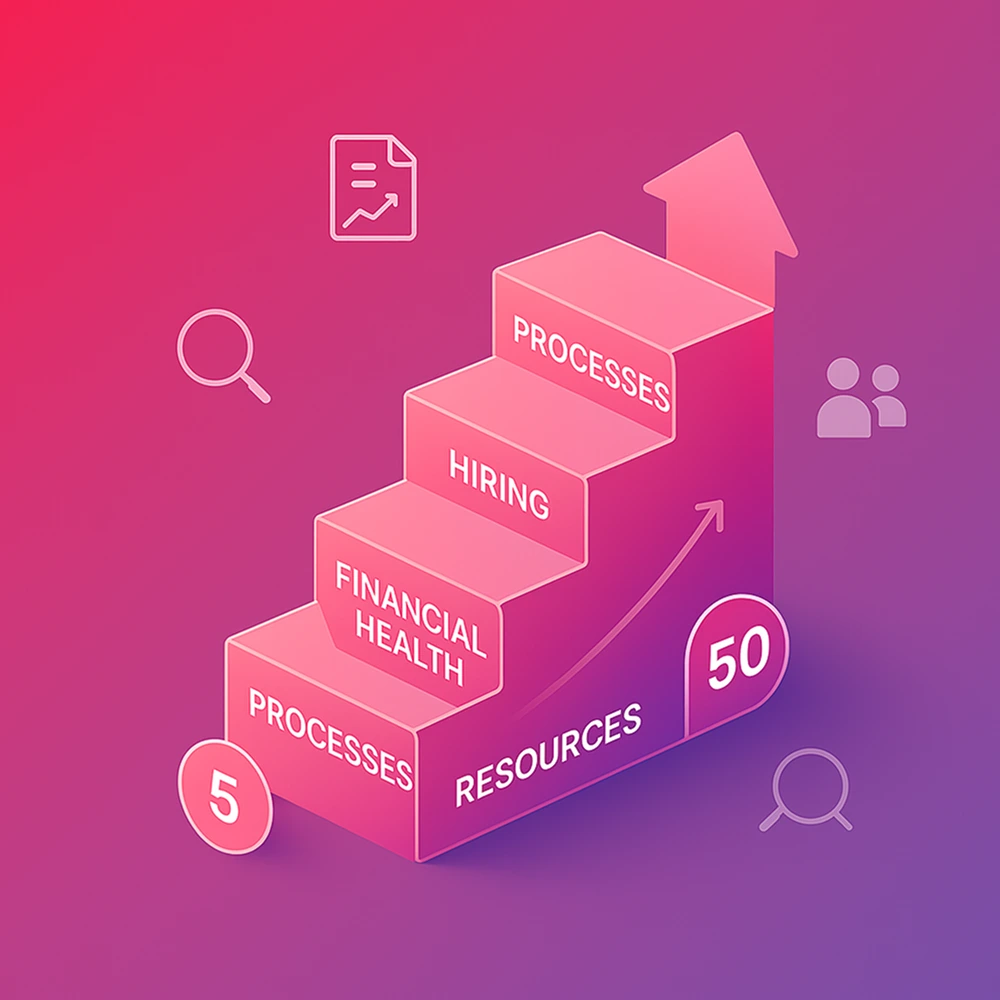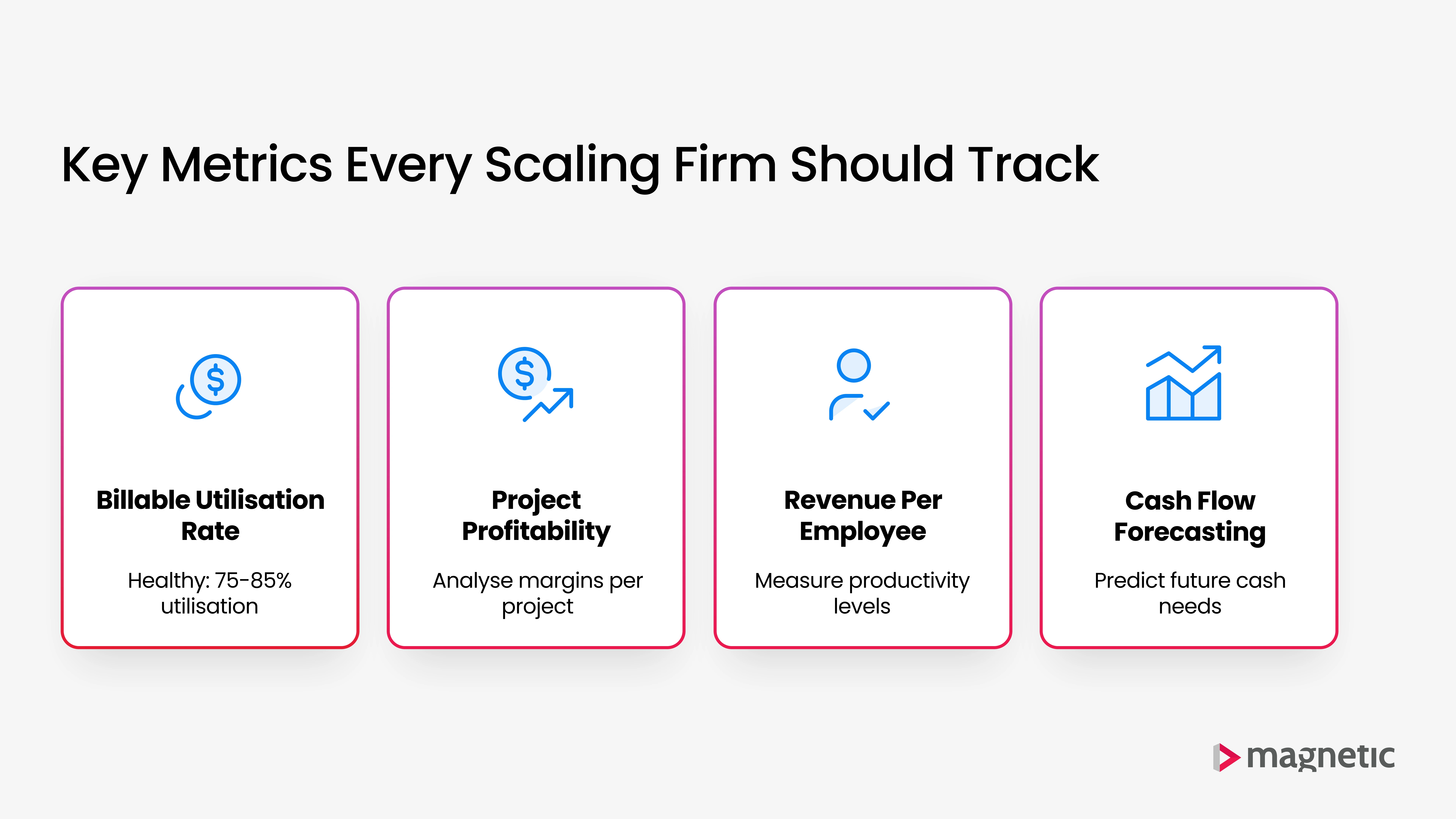Table of contents
Subscribe to our newsletter
Thank you! Your submission has been received!
Oops! Something went wrong while submitting the form.


Architects build and grow by their very nature, so ambitions of growth at a company level is almost a certainty.
Bigger projects, a larger team, and a stronger reputation. But scale too quickly without the right structure and the cracks start to show. Projects drag, revenue leaks away, and the team burns out trying to keep up. The firms that grow profitably do more than just win new work, they keep a tight hold on visibility, resourcing, and profitability at every step. That is where a clear growth strategy makes all the difference, (backed by the right tools, of course).
Growing an architecture firm should be exciting. Bigger projects, new clients, and more people around the table. But as the workload grows, so does the complexity. Deadlines tighten, client demands multiply, and the coordination that once felt simple starts to feel like juggling in a windstorm.
Bringing in more staff can help, but it also pushes up your fixed costs. Every new hire needs to be kept busy on the right work, and that balance gets harder to strike the bigger you get. Too much downtime and you are losing money. Push too hard and quality drops while your team burns out.
The systems that worked for a tight five-person crew rarely hold up when you hit double digits. Spreadsheets get messy, communication slips, and suddenly it takes longer to find out where a project actually stands than to get the work done.
Somewhere in all that noise, the saddest thing happens – owners start to lose the clear line of sight they once had, and their vision gets lost in the madness.
Scaling is not just about saying yes to more work. It is about keeping control of the moving parts, holding onto profitability, and making sure growth does not become the thing that breaks you.
Fast growth looks good on the surface, but without structure, the numbers underneath can start to tell a very different story.
One of the biggest drains comes from hiring too quickly. If there is not enough billable work to keep everyone busy, you end up paying for time that does not earn a return. Even worse is when staff are busy, but on the wrong work. Misallocated resources slow delivery, frustrate clients, and still eat into margins.
Then there is scope creep. Without sharp project tracking, extra requests slip through without being billed. One or two might seem harmless, but across several projects the lost revenue can be substantial.
Here is the reality. Adding five employees without optimised utilisation can cut profit margins by 10% - 15%. That is a big hit for any firm, and once that money is gone it is difficult to claw back.
Growth without structure is as expensive as it is messy. The firms that get it right grow deliberately, keep utilisation in check, and make sure every new hire is backed by real, billable demand.
Scaling an architecture firm without losing control or profitability means having a plan that goes beyond “hire more people.”
These five steps form a framework that keeps growth structured and margins intact.
1. Build Project Visibility
You cannot manage what you cannot see. Track timelines, budgets, and profitability on every project. This makes it easier to spot delays, control costs, and see which projects are driving your margins.
2. Optimise Resource Allocation
Put the right people on the right projects. Avoid overloading your top performers while others sit underutilised. Balanced workloads keep delivery smooth and staff engaged.
3. Set Hiring Triggers Based on Utilisation
Do not hire on gut feel. Use utilisation data to know when the team is truly at capacity and when you can deliver more with the people you already have.
4. Monitor Financial Health
Scaling puts pressure on cash flow. Keep billing, receivables, and expenses aligned so growth does not tip you into a liquidity crunch.
5. Standardise Processes and Reporting
As the team grows, ad-hoc ways of working break down. Create repeatable workflows and clear reporting so everyone is working from the same playbook.
Scaling without measuring the right numbers is like building without a blueprint. You might make progress, but you will not know if you are heading in the right direction until it is too late. These four metrics keep a growing architecture firm on track.
Tracking these metrics early in your scaling journey means you can spot problems before they hit your bottom line. It is far easier to correct course when the warning signs are small than to try and recover after profitability has already taken a hit.

As an architecture firm grows, so does the volume of information to manage. Projects, timelines, budgets, resource schedules, and invoices all need to be tracked and updated. Trying to manage this with scattered tools or spreadsheets is a recipe for missed details and slower decisions.
The right software brings everything into one place. Project and resource data sit side by side, so you can see not just what work is in progress, but who is doing it and how that impacts timelines and margins. This visibility makes it far easier to allocate staff effectively and prioritise the right projects.
Automated reporting turns utilisation rates, profitability figures, and forecasts into information you can act on without hours of manual data entry. Instead of chasing updates, you can focus on decisions that keep the firm moving forward.
Technology can also highlight risks before they become problems. Spotting a drop in billable hours early can prevent under-billing. Seeing a surge in workload ahead of time gives you the chance to line up additional capacity without rushing into costly hires.
For many firms, this shift from reactive to proactive decision-making is the difference between growth that eats into margins and growth that protects them.
This is where a platform like Magnetic becomes a quiet advantage, bringing all the moving parts of a scaling firm into one clear view.
Scaling a firm is much easier when you have one place to manage everything. Magnetic brings projects, resources, and financials together in a single platform, so you can run the business with clarity instead of juggling multiple systems.
Its dashboards give you a live view of the numbers that matter most. You can see utilisation rates across the team, track project profitability, and check the health of your pipeline in real time. That means you are not relying on old reports or chasing updates. You have the information you need when you need it.
Magnetic also supports better decision-making as you grow. If utilisation is edging too high, you will know it is time to hire. If the pipeline is looking light, you can focus on winning new work before it impacts revenue. By linking project data with financial performance, you can forecast with confidence and allocate resources where they will have the most impact.
Architecture firms that scale with Magnetic maintain clarity and protect margins, even as headcount and complexity grow. It is the kind of tool that works quietly in the background, giving you the space to focus on design, delivery, and growth without losing sight of profitability.
Growth without visibility is a gamble. You might land bigger projects and a larger team, but if you cannot see where time, money, and resources are going, your margins will suffer.
The firms that scale successfully combine operational discipline with the right tools. They track the metrics that matter, make data-driven hiring and resourcing decisions, and keep a close eye on project profitability. This approach keeps the business stable while still allowing it to grow.
Magnetic brings all of this into one place, giving you live insight into projects, resources, and financial performance. With that clarity, you can scale with confidence rather than crossing your fingers and hoping for the best.
If you are ready to see how this works in practice, book a demo and explore how Magnetic can help your architecture firm grow from 5 to 50 employees without losing control of your margins.
The most common risk is losing visibility over projects, resources, and finances. As the team grows, information becomes scattered, making it harder to spot problems early. Without that clarity, profitability can slip before you even notice.
.svg)
Focus on efficiency rather than headcount. By tracking utilisation and project profitability closely, you can make the most of your existing team and only hire when the data shows you need extra capacity.
.svg)
Billable utilisation rate, project profitability, revenue per employee, and cash flow forecasting are key. These metrics show whether your growth is sustainable and where to make adjustments.
.svg)
Yes. The right platform brings all your project, resource, and financial data into one place, making it easier to allocate resources effectively, forecast accurately, and catch revenue leaks before they add up.
.svg)
Accurate forecasting shows you what is coming, from workload peaks to potential slow periods. It helps you plan hiring, secure new work, and balance resources before problems appear.
.svg)
The clearest signal is utilisation data. When your team’s billable utilisation consistently pushes past healthy levels (around 75–85%), it’s a sign that workload is stretching your existing capacity. Rather than hiring on gut feel, use project forecasts and pipeline visibility to confirm whether the demand is sustainable before adding headcount.